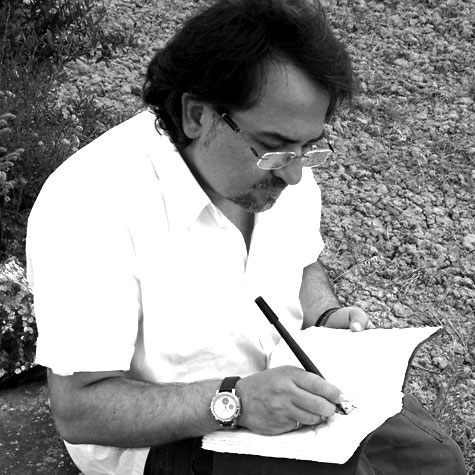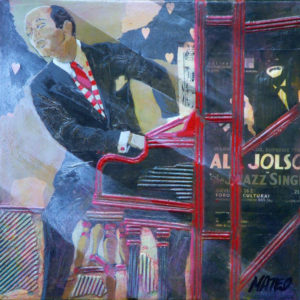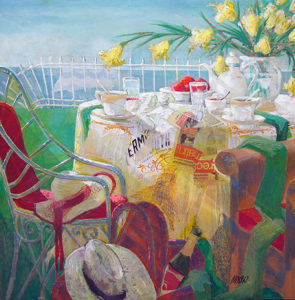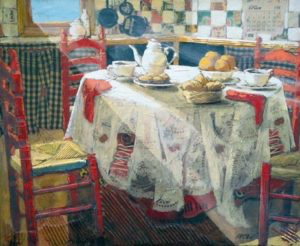ESCATRON, 1958 Mateo

With Mateo painting is a bond that is placed, through aesthetics, in a higher place of affection among the spectators of each painting.
In most of his works highlight the entrances of light and windows, which act as eyes through which we perceive the exterior, the creation, the universe and that lead us to the external dimension.
BIOGRAPHY
Born in Escatrón (Zaragoza, 1958), in 1975 he began his artistic studies at the School of Applied Arts and Artistic Trades of Barcelona and in 1976 he entered the Faculty of Fine Arts Sant Jordi of Barcelona. In 1982 he obtained a Bachelor’s Degree in this Faculty and in 1988 he passed the free examinations of Drawing as an added numerary professor of secondary education in Plastic and Visual Education. He completed doctoral studies on “The representation of anatomical knowledge in the scientific and artistic iconography of the human body”, at the Faculty of Fine Arts of Barcelona. Since 1975, the year in which he holds his first exhibition, he has shown us his work in several halls, galleries, art fairs, contests and competitions of national and international character, obtaining important distinctions. His works always revolve around the human being, present or not, graphically. We sense their presence by the objects that we usually use in our daily life: armchairs, books, cups, coffee makers, newspapers, pencils, signs… To be highlighted, in most of the works, the light and the windows, which act as eyes through which we perceive the exterior, the creation, the universe and that lead us to the external dimension.
THE DEEPLY EVOCATIVE PAINTING OF JOAQUIN MATEO
by Josep M. Cadena
I remember when, in November 2016, Joaquín Mateo exhibited his work in the Sala Rusiñol in Sant Cugat where he now returns, because his well-worked intimacy aroused remarkable interest, since, despite representing private scenes, he knows how to make them extensive and participatory all those who obtain the pleasure of contemplating them. The private rooms with sea views, where books and musical instruments have a remarkable presence, have their counterpoint in the open landscapes mainly belonging to large cities.
Mateo’s pictorial ability is wide and he successfully taps several emotional registers. The individual rooms appeal to the intimate refuge of the person where reflection and introspective activity take place, while the street is the space of socialization par excellence and where we discover the unfathomable variety of the world and human realizations.
The artist is at ease in the company of a library, a stereo and a glass of wine. The words read tell stories and bring knowledge, the musical melodies caress the ear and stimulate sensitivity, and the grape product tastes the palate and predisposes the spirit to pleasure.
At the same time, the painter knows that the outside is the source of food inside us, which is why in the dining rooms and bedrooms of the paintings there is a window that hints at the next journey to undertake. The destination may be a distant and exotic city, but not necessarily, because to enjoy places that overwhelm the visitor is not required to travel thousands of miles, and any of us is well within reach ecstasy in front of Gaudí’s La Pedrera, the Roman amphitheater of Tarragona or, a little further away, the flour mills of the Jonquet district in Palma de Mallorca.
Joaquín Mateo’s art has the virtue of enveloping us both in an intimate atmosphere and of making us breathe deeply in an open space, and his paintings, solidly structured, encourage us to travel inside and outside. We gladly accept your invitation and let ourselves enter into your hand in a deeply aesthetic and enriching experience.
THE IDEAL SPACES OF JOAQUIN MATEO
by Josep M. Cadena
The home is the refuge of personality, the shelter sheltered from social conditioning where we can be ourselves without the pressure of what they will say, and this space of privacy Joaquín Mateo (Zaragoza, 1957) dedicates mostly the paintings he exhibits in the room Rusiñol de Sant Cugat.
The intimate rooms represented by the artist are populated with objects that more accurately portray facial features to their owners. Some glasses on top of an open book express the longing for knowledge that lasts despite the passage of time that detracts from our strength and forces us to redouble our efforts if we do not want to lower the exacting pace we have imposed on ourselves, always on the road forward. lifetime; a cup of coffee shows the value of the reflective pleasure that is at the service of the individual and that is opposed to the uncontrolled desire that engulfs its victim in an annihilating spiral; and a violin and some scores claim that the existence must follow a pattern in which sensitivity dominates.
Joaquin Mateo estimates high culture but also the most popular artistic manifestations, since he knows that the two fields offer works of interest that satisfy equally legitimate tastes, hence in his canvases we find both a Bach composition and a poster of a music singer light, books and comics, and traditional press and free newspapers. At the same time, the printed letter makes an appearance with messages that urge us to be happy, remind us that it is now or never, and ask us who we share our time with.
But even though sometimes we are tempted to seclude ourselves in our custom made private sphere, we have to accept our condition and responsibility of social beings and open ourselves to the outside world, even if it is to receive all the good that this can offer us and to contribute what we can do to make a better place. For this reason, the paintings of Joaquin Mateo, the balconies and the windows are open and allow to see a view that can be as charming as the city of Paris or a blue sea lock. The exhibition is entitled Spaces of life, since there are two spaces that interact, the private and the public. And the lesson that Joaquin Mateo gives us is that we have to cultivate the spirit and sensitivity in the first to transform the second better.





